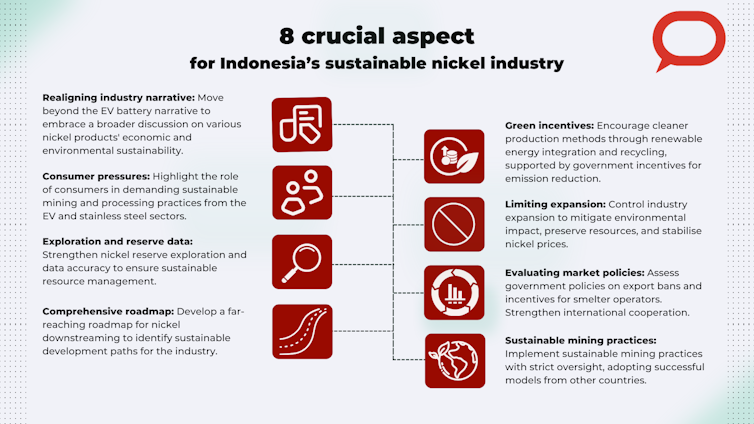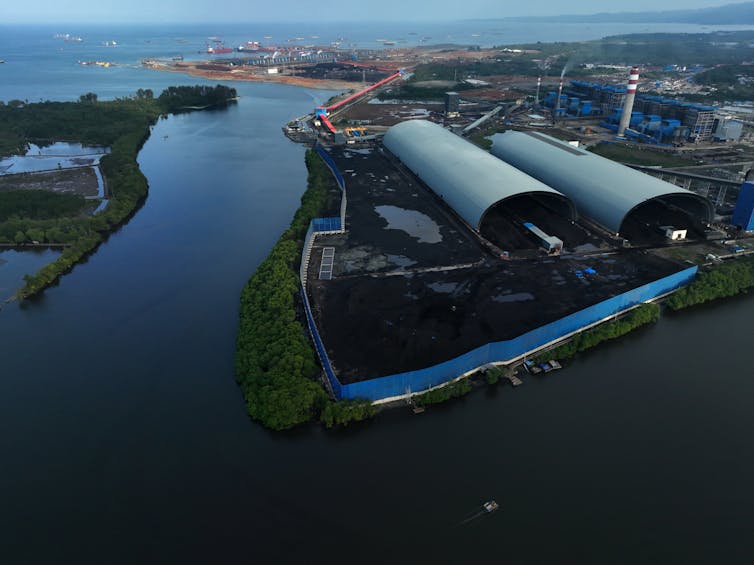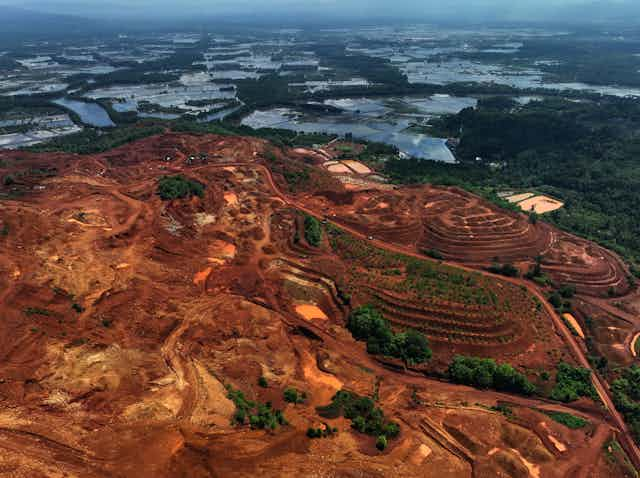President Joko “Jokowi” Widodo’s ambition to turn Indonesia into a global hub for electric vehicle (EV) battery production has thrust the nation’s mining commodities, particularly nickel, into the spotlight.
Since a 2020 law ordering the processing of mining commodities into more valuable, marketable products (downstreaming), Indonesia’s nickel production and export have surged sharply. More is expected in the coming years as the government aims to have 30 new nickel smelters operational this year, a significant addition from 13 smelters in construction by mid-2023.
However, controversies surrounding Indonesia’s nickel sector are difficult to ignore. Environmental and social impacts of nickel mining and processing — from deforestation, biodiversity loss, water and air pollution and the displacement of local communities — frequently make headlines. Additionally, the tumult caused by Indonesia’s nickel export ban, which led to a 2021 lawsuit at the World Trade Organization, and the collapse of nickel prices due to oversupply have been notable.
Issues around the country’s nickel industry were also politicised during the 2024 Presidential Election as competing candidates used them to pounce on their opponents and campaign teams. Prabowo Subianto and Jokowi’s son, Gibran Rakabuming Raka, who rose as the winning pair in this year’s presidential election, have clearly indicated their intention to continue Jokowi’s nickel program. The two and their supporters accused Tom Lembong, Jokowi’s former trade ministry and now heading presidential candidate Anies Baswedan’s campaign team, of spreading public lies about how Indonesia played a big part in plummeting global nickel prices.
As the world’s largest nickel producer and reserve holder, according to data from the United States Geological Survey, downstream processing is seemingly inevitable for Indonesia. Yet, the sustainability of continuous extraction and value addition remains a question.
To address this, The Conversation Indonesia interviewed Putra Adhiguna, Managing Director of the Energy Shift Institute; Putra Hanif Agson Gani, a doctoral candidate in Minerals and Energy Resources Engineering from the University of New South Wales Sydney; and Krisna Gupta, a senior fellow from the Center of Indonesian Policy Studies, to dissect the crucial aspects of ensuring a sustainable nickel industry from upstream to downstream.
Here are eight crucial aspects to consider to ensure Indonesia’s nickel sector’s environmental and economic sustainability.

1. Realigning the nickel industry narrative
Adhiguna asserted the complexity of Indonesia’s nickel industry’s sustainability issues, entwined with economic, social and environmental concerns, becomes more convoluted due to the potential conflicts of interest stemming from national and local officials’ involvement in nickel management. The power dynamics risk narrowing the discourse on nickel to specific, somewhat constricted issues.
For instance, the narrative around nickel downstreaming, heavily promoted by Jokowi, is often linked to Indonesia’s ambition to become a global EV battery producer. In reality, 70% of Indonesia’s nickel is absorbed for stainless steel production, a primary material for items from kitchen utensils to skyscrapers and wind turbines. Only 5% of the total production goes into batteries.
“In my view, we will never become a global EV giant. I believe that (narrative) is misleading,” Adhiguna said. His research indicates Indonesia currently controls only 0.4% of the global electric battery market.
According to Adhiguna, the nickel industry’s strong narrative for EV battery development hinders a comprehensive discussion of its economic and environmental sustainability. Nonetheless, he argued that nickel downstreaming for battery raw materials must proceed alongside other derivative products. But at the same time, the government should realign its ambitions and narratives that have become the public discussion.
2. Incentives for decarbonisation and waste management
According to Gani, the nature of the mining and processing industry makes it challenging to be entirely “clean” environmentally.
At the upstream level, emissions arise directly and indirectly from mining equipment and the energy needed for processing). Land dredging also alters the landscape, potentially impacting wildlife.
Meanwhile, downstream, nickel processing in smelters using pyrometallurgy (burning processes) emits high air pollution levels and produces exhaust gases that contaminate the air. Hydrometallurgy – the extraction of nickel with chemical solutions mainly used for producing battery raw materials – generates waste that risks polluting water and soil.
Gani suggested that companies integrate their power sources with renewable energy to reduce the nickel industry’s environmental impact. Investing in low-emission equipment can also be part of the solution.
Companies can also manage or recycle their waste for reuse. For example, processing exhaust gases from smelters into hydrogen can be used again as an energy source.
However, managing environmental impacts is a costly undertaking, leading most mining companies in Indonesia to avoid them. Gani noted that companies mostly tried to meet the demand for a “green” mining industry by simply adhering to the Ministry of Energy and Mineral Resources’ mandated use of biodiesel – and even that comes at a high cost.
This is where the nickel industry needs government support. “From the government itself, I believe there must be incentives for emission reduction,” he asserted.

3. Pressures from consumers
Adhiguna noted that government efforts alone were insufficient to enhance the nickel industry’s environmental sustainability. Indonesian nickel consumers can also play a significant role in demanding sustainable mining and processing practices.
For instance, Indonesian nickel product users could adopt the European Union’s policy requiring bioenergy only from sustainably managed sources free from deforestation. Although this policy has created tensions with Indonesian palm oil producers, the stringent regulations eventually forced companies to adapt.
According to him, the most feasible demands for sustainable nickel could come from producers and consumers of electric vehicles and their components, such as batteries. These manufacturing companies could also make collective demands. However, implementation is challenging due to the current trade tensions between China and other countries.
Adhiguna added that another approach is for consumers of nickel pig iron (processed nickel for stainless steel raw materials) to demand that smelter operators adopt more environmentally friendly practices, including the sustainable extraction of mined ores.
“Pressure is also critically needed for stainless steel products and their derivatives,” he said.
4. Limiting expansion
Adhiguna believes restricting the industry’s expansion is a viable solution to address environmental impacts, preserve reserves, and rectify the plummeting nickel prices in the market.
The decline in nickel prices debunks the government’s argument that nickel exploitation aims to to improve the welfare of the people. Massive nickel mining since 2013 has led to an oversupply, causing prices to drop significantly from a decade ago.
Again, Adhiguna recommended that expansion restrictions start in the downstream sector or smelters. Nickel ore production is affected by the demand for processing facilities and limiting the number of smelters would gradually improve nickel ore prices.
“The faster the growth of smelters, the more ore mining and deforestation will inevitably follow. Adding one smelter means increasing the growth rate for deforestation,” he elaborated.
5. Strengthening exploration and nickel reserve data
The Indonesian Nickel Miners Association (APNI) stated earlier this year that Indonesia’s high-grade nickel ore reserves, mainly used for steel production, would be depleted within six years. Although the government has refuted APNI’s statement, it underscores that Indonesia’s nickel is finite.
“Check Indonesia’s nickel reserves accurately. Are there new explorations? Are new mining locations in protected forest areas?” asked Gupta.
Gani also emphasised the importance of reducing environmental impacts starting from the exploration stage of mining. Exploration that considers environmental impacts can lead to mine designs that minimise deforestation and other environmental risks.
6. Evaluating export bans, strengthening cooperation

The economic sustainability of the nickel industry extends beyond production activities. Market conditions and the economic value of nickel must also be carefully considered. Without adequate profits, the transition to sustainability seems distant.
To attain economic viability, Gupta argued that the Indonesian government needed to evaluate whether tax holidays and the obligation for smelter operators to utilise local products truly promote business sustainability. He noted how, amidst these demands, the government had paradoxically provided tax incentives for non-nickel electric vehicles.
According to Gupta, this evaluation should also be accompanied by a comprehensive comparative study to determine whether the benefits of incentive policies for smelters outweigh the benefits of exporting nickel ore.
“It could turn out that this is more detrimental than just exporting raw nickel. Given the unclear trajectory towards EV (with nickel batteries), it’s worth considering whether these incentives are sustainable,” he added.
Gupta also recommended that the government strengthen international nickel supply chain cooperation rather than impose export bans, which do not always benefit Indonesia. Almost 90% of Indonesia’s nickel export is shipped to China.
“Investment related to nickel downstreaming in Indonesia could be more competitive and coveted by companies from various countries instead of just a few,” Gupta suggests, adding the importance of working with multilateral organisation such as OECD.
7. Drafting a comprehensive roadmap
Both Gupta and Adhiguna questioned how far Indonesia can realistically go in implementing nickel downstreaming. With China currently experiencing an oversupply of electric batteries, Adhiguna reiterated how important it was for Indonesia to have a far-reaching roadmap for its nickel ambition.
Meanwhile, Gupta believes Indonesia needs to reassess how far investor interest in developing nickel downstreaming extends. “If it doesn’t reach cars, maybe motorcycles are okay. If it reaches batteries, well, that’s something. Or even if we can only go for stainless steel, that’s not bad either,” he said.
Echoing this sentiment, Gani also believes it’s time for the government to explore other nickel products that could provide added value – not just for batteries. After all, nickel is widely used in everyday life, from kitchen utensils and electronic equipment to supporting various industrial sectors.
8. Sustainable mining practices
By integrating the aspects mentioned above, according to Gani, it’s time for sustainable mining practices to serve more than just a slogan, applied with tightened oversight from the government.
Indonesia could emulate countries that have successfully implemented sustainable practices, such as Canada with its biomass-powered mining energy sources.
He added that companies could also show their commitment by purchasing International Renewable Energy Certificates, demonstrating how much of their electricity comes from renewable energy.
“Besides being a material that can help advance renewable energy in Indonesia, it would also be beneficial for the nickel industry to refer to sustainable mining practices in its exploration, exploitation, and theory processes,” Gani concluded.


